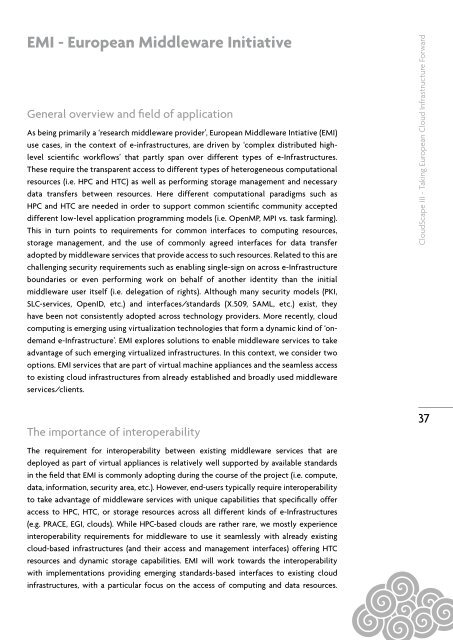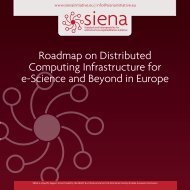SIENA European Roadmap on Grid and Cloud Standards for e-Science and Beyond
SIENA European Roadmap on Grid and Cloud Standards for e ...
SIENA European Roadmap on Grid and Cloud Standards for e ...
You also want an ePaper? Increase the reach of your titles
YUMPU automatically turns print PDFs into web optimized ePapers that Google loves.
EMI - <str<strong>on</strong>g>European</str<strong>on</strong>g> Middleware Initiative<br />
General overview <strong>and</strong> field of applicati<strong>on</strong><br />
As being primarily a ‘research middleware provider’, <str<strong>on</strong>g>European</str<strong>on</strong>g> Middleware Intiative (EMI)<br />
use cases, in the c<strong>on</strong>text of e-infrastructures, are driven by ‘complex distributed highlevel<br />
scientific workflows’ that partly span over different types of e-Infrastructures.<br />
These require the transparent access to different types of heterogeneous computati<strong>on</strong>al<br />
resources (i.e. HPC <strong>and</strong> HTC) as well as per<strong>for</strong>ming storage management <strong>and</strong> necessary<br />
data transfers between resources. Here different computati<strong>on</strong>al paradigms such as<br />
HPC <strong>and</strong> HTC are needed in order to support comm<strong>on</strong> scientific community accepted<br />
different low-level applicati<strong>on</strong> programming models (i.e. OpenMP, MPI vs. task farming).<br />
This in turn points to requirements <strong>for</strong> comm<strong>on</strong> interfaces to computing resources,<br />
storage management, <strong>and</strong> the use of comm<strong>on</strong>ly agreed interfaces <strong>for</strong> data transfer<br />
adopted by middleware services that provide access to such resources. Related to this are<br />
challenging security requirements such as enabling single-sign <strong>on</strong> across e-Infrastructure<br />
boundaries or even per<strong>for</strong>ming work <strong>on</strong> behalf of another identity than the initial<br />
middleware user itself (i.e. delegati<strong>on</strong> of rights). Although many security models (PKI,<br />
SLC-services, OpenID, etc.) <strong>and</strong> interfaces/st<strong>and</strong>ards (X.509, SAML, etc.) exist, they<br />
have been not c<strong>on</strong>sistently adopted across technology providers. More recently, cloud<br />
computing is emerging using virtualizati<strong>on</strong> technologies that <strong>for</strong>m a dynamic kind of ‘<strong>on</strong>dem<strong>and</strong><br />
e-Infrastructure’. EMI explores soluti<strong>on</strong>s to enable middleware services to take<br />
advantage of such emerging virtualized infrastructures. In this c<strong>on</strong>text, we c<strong>on</strong>sider two<br />
opti<strong>on</strong>s. EMI services that are part of virtual machine appliances <strong>and</strong> the seamless access<br />
to existing cloud infrastructures from already established <strong>and</strong> broadly used middleware<br />
services/clients.<br />
<strong>Cloud</strong>Scape III - Taking <str<strong>on</strong>g>European</str<strong>on</strong>g> <strong>Cloud</strong> Infrastructure Forward<br />
The importance of interoperability<br />
The requirement <strong>for</strong> interoperability between existing middleware services that are<br />
deployed as part of virtual appliances is relatively well supported by available st<strong>and</strong>ards<br />
in the field that EMI is comm<strong>on</strong>ly adopting during the course of the project (i.e. compute,<br />
data, in<strong>for</strong>mati<strong>on</strong>, security area, etc.). However, end-users typically require interoperability<br />
to take advantage of middleware services with unique capabilities that specifically offer<br />
access to HPC, HTC, or storage resources across all different kinds of e-Infrastructures<br />
(e.g. PRACE, EGI, clouds). While HPC-based clouds are rather rare, we mostly experience<br />
interoperability requirements <strong>for</strong> middleware to use it seamlessly with already existing<br />
cloud-based infrastructures (<strong>and</strong> their access <strong>and</strong> management interfaces) offering HTC<br />
resources <strong>and</strong> dynamic storage capabilities. EMI will work towards the interoperability<br />
with implementati<strong>on</strong>s providing emerging st<strong>and</strong>ards-based interfaces to existing cloud<br />
infrastructures, with a particular focus <strong>on</strong> the access of computing <strong>and</strong> data resources.<br />
37



